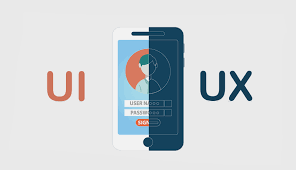
UX UI designers in Delhi
- Mar 21 2025

In today’s digital world, where every interaction with an application or website shapes a user's perception of a brand, User Interface (UI) and User Experience (UX) design are paramount. These two elements play a critical role in determining the success of digital products. UI/UX design is not just about aesthetics but focuses on usability, user satisfaction, and creating a seamless interaction between the user and the system. Businesses that invest in professional UI/UX design services enhance their products' appeal and functionality, fostering customer loyalty, improving conversions, and reducing bounce rates. Whether it’s a website, mobile app, or enterprise software, the design of a user interface combined with an exceptional user experience can transform an average digital product into something extraordinary. UI (User Interface) Design refers to the visual elements of an application or website. It's everything that the user interacts with, such as buttons, icons, menus, typography, color schemes, and layout.A well-designed user interface prioritizes the interface's visual structure and aesthetics, making it visually appealing, dependable, and easy to use. Good UI design aims to create a positive and engaging interaction. It addresses questions like: Is the interface clean and uncluttered? Are the components aesthetically pleasing and simple to comprehend? Are the buttons and menus intuitively placed for ease of use? UI designers work with graphic design software and prototyping tools to create mockups and wireframes, ensuring that the design is both functional and beautiful. The process of developing and refining user experience when interacting with a product is known as UX (User Experience) Design. UX design is about understanding the needs, frustrations, and behaviors of the target audience and tailoring the product’s functionality and interface to meet those needs effectively. UX design encompasses many stages, including: User Research – Understanding the users’ goals, motivations, and pain points. Information Architecture – Structuring the content and flow of information in a logical and easy-to-navigate way. Wireframing and Prototyping – Developing low-fidelity sketches and interactive models of the product to validate design concepts. Usability Testing – Evaluating how users interact with the product and making necessary adjustments to improve usability. Iterative improvement is the process of continuously improving the design in response to user input and test findings. UX designers aim to ensure that a product is user-centered, solving real problems while providing a pleasurable experience. It is impossible to exaggerate the significance of UI/UX design services. Here’s why: Users form an opinion about a website or app within seconds of interaction. An intuitive, visually appealing interface can create a strong first impression and increase the likelihood of user engagement. If the UI is poorly designed, users are more likely to leave the product without further interaction. UI/UX design services go beyond just making things look pretty. A well-designed interface ensures that the product is easy to use, intuitive, and functional. For example, in mobile apps, users should be able to navigate through the screens effortlessly and reach their goals quickly. Poor navigation or confusing layouts can lead to frustration, resulting in users abandoning the product. When users have a positive experience, they are more likely to take desired actions, whether it's making a purchase, signing up for a newsletter, or downloading an app. A well-designed UI/UX can guide users through the conversion funnel with minimal friction, boosting conversions and ultimately helping businesses meet their objectives. UI/UX design is a key factor in user retention. A seamless experience encourages users to return to the product or service repeatedly. Furthermore, a unified and consistent design across the user journey promotes brand loyalty and trust. With so many businesses operating in the digital space, having a user-friendly, visually appealing product can set you apart from competitors. Well-executed UI/UX design can be the differentiating factor between users choosing your app or website over another. A focus on accessibility in UI/UX design ensures that people with disabilities can also engage with the product. This could involve using high-contrast colors, providing keyboard shortcuts, ensuring compatibility with screen readers, and so on. Accessible design can open up new customer bases and ensure a more inclusive user experience. A comprehensive UI/UX service focuses on various aspects of design to create an optimal experience for users. These include: Understanding the users is the first step in crafting a compelling UI/UX design. Conducting thorough research helps identify pain points, desires, and behavior patterns. The insights gathered are used to create user personas, which represent different segments of your target audience. Without any design components, wireframing is the blueprint of a website or application that concentrates on the structure and layout. Wireframing is the blueprint of a website or app, focusing on the layout and structure without any design elements. It helps stakeholders visualize the flow of the product before diving into intricate design work. Prototypes take this a step further by allowing users to interact with the interface, providing a hands-on experience of the product’s functionality. Interaction design focuses on the way users interact with the system. This includes button animations, page transitions, hover states, and other interactive elements that improve engagement. The goal is to make interactions intuitive, fluid, and enjoyable. This involves creating the visual elements, like color palettes, typography, and iconography, that contribute to the overall aesthetic. Visual design must align with the brand's identity while also considering user preferences and accessibility standards. Usability testing is a critical part of the UI/UX design process. It involves observing real users as they interact with the prototype and gathering feedback to identify pain points and areas for improvement. This process helps identify usability issues before the product is launched, reducing the risk of a poor user experience. With the increasing use of mobile devices, responsive design is a must. This ensures that the product’s interface adapts to various screen sizes, from desktops to smartphones and tablets, providing a consistent experience across all platforms. A professional UI/UX design service typically offers a full range of services, including: Consultation and Strategy – Understanding your business, goals, and target audience. Wireframing and Prototyping – Creating low-fidelity prototypes to visualize the flow. UI Design – Developing high-fidelity UI designs with attention to details like colors, fonts, and branding. UX Research – Conducting user research, interviews, surveys, and usability testing to refine the design. Interaction Design – Designing engaging, interactive features that delight users. Development Collaboration – Working with developers to ensure seamless integration of the design into the final product. Post-launch Support – Providing support and refining the design after the product goes live based on user feedback. UI/UX design services are crucial for any digital product that wants to stand out in today’s competitive landscape. A user-centric approach ensures that products are not only aesthetically pleasing but also intuitive and functional. From improving first impressions to increasing conversions and user retention, investing in professional UI/UX design services can have a significant impact on the success of a product. Businesses that prioritize great design will not only attract and retain more users but also position themselves as leaders in their industry. In the digital age, where user experience often determines the difference between success and failure, high-quality UI/UX design is not just an option—it’s a necessity.What is UI Design?
What is UX Design?
The Value of UI/UX Design in the Current Digital Environment
1. First Impressions Matter
2. Enhanced Usability and Functionality
3. Higher Conversion Rates
4. Customer Retention
5. Competitive Advantage
6. Improved Accessibility
Key Elements of UI/UX Design
1. User Research and Persona Creation
2. Wireframing and Prototyping
3. Interaction Design
4. Visual Design
5. Usability Testing
6. Responsive Design
UI/UX Design Services: What to Expect
Conclusion
Leave Comments